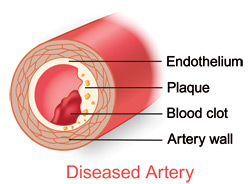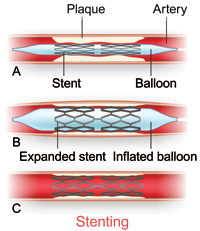Related terms: percutaneous coronary intervention, PCI, percutaneous transluminal coronary angioplasty, PTCA
Coronary artery disease (CAD) affects more than 15 million Americans, making it the most common form of heart disease. CAD most often results from a condition known as atherosclerosis, which happens when a waxy substance forms inside the arteries that supply blood to your heart. As the plaque builds up, the artery narrows, making it more difficult for blood to flow to the heart.
 As the blockage gets worse, blood flow to the heart slows and a condition called angina may develop. In time, the narrowed or blocked artery can lead to a heart attack.
As the blockage gets worse, blood flow to the heart slows and a condition called angina may develop. In time, the narrowed or blocked artery can lead to a heart attack.
A number of medicines can be used to relieve the angina pain that comes with CAD. But, because medicines cannot clear blocked arteries, a very narrowed coronary artery may need more treatment to reduce the risk of a heart attack. One option is a percutaneous coronary intervention (PCI), such as balloon angioplasty or a stent.
What is balloon angioplasty?
Interventional cardiologists perform angioplasty, which opens narrowed arteries. They use a long, thin tube called a catheter that has a small balloon on its tip. They inflate the balloon at the blockage site in the artery to flatten or compress the plaque against the artery wall. Angioplasty is also called percutaneous transluminal coronary angioplasty (PTCA).
Although this topic deals with the coronary arteries in the heart, balloon angioplasty can also be used to open narrowed vessels in many other parts of your body. For example, doctors can perform carotid angioplasty to open narrowed carotid arteries, which are the arteries that supply blood to the brain. A stroke most often occurs when the carotid arteries become blocked and the brain does not get enough oxygen. Angioplasty can also be performed in the aorta (the main artery that comes from your heart), the iliac artery (in your hip), the femoral artery (in your thigh), the popliteal artery (behind your knee), and the tibial and peroneal arteries (in your lower leg).
 What is a stent?
What is a stent?
A stent is a small, mesh-like device made of metal. When a stent is placed inside of a coronary artery, it acts as a support or scaffold, keeping the vessel open. By keeping the vessel open, the stent helps to improve blood flow to the heart muscle and reduce the pain of angina. Stent procedures are usually used along with balloon angioplasty. In fact, about 80% of patients who have balloon angioplasty will have a stent placed as well.
Just like with balloon angioplasty, doctors are now using stents in many other parts of the body—not just the heart. Stents can also be placed in the carotid arteries in the neck, in the aorta, and in the peripheral arteries in the legs.
| In the news — August 2013
Heart Stent Procedure Explained for NPR
Former President George W. Bush underwent a successful heart procedure to clear a blockage discovered during a routine physical. Dr. James T. Willerson, THI president, explains the stent procedure and the consequences of coronary artery disease for National Public Radio. Listen to the 3 minute interview at WBUR.org in Boston.
|
What can I expect during a balloon angioplasty or stent procedure?
The procedures are performed in the cardiac catheterization laboratory (also called the cath lab).
Patients are usually told not to eat or drink anything after midnight the night before the procedure. If you have diabetes, you should talk to your doctor about your food and insulin intake, because not eating can affect your blood sugar levels.
Talk to your doctor about any medicines (prescription, over-the-counter, or supplements) that you are taking. This is especially important if you are taking blood-thinning medicines or anti-platelet medicines. You will most likely have blood tests, an electrocardiogram, and a chest x-ray taken before the procedure.
|
|
|
Catheterization laboratory
|
|
Once you are in the cath lab, you will see television monitors, heart monitors, and blood pressure machines. You will lie on an examination table, which is usually near an x-ray camera.
Small metal disks called electrodes will be placed on your chest. These electrodes hook up to an electrocardiogram machine which monitors your heart rhythm during the procedure.
A needle with a tube connected to it will be put in your arm. This is called an intravenous line or IV. You will get a mild sedative through the IV to relax you throughout the procedure.
You will be given an anesthetic medicine with a needle to numb the area around where the catheter will be inserted and then a small incision will be made in the skin. When doctors see the artery into which the catheter will go, a special needle is used to penetrate it. Doctors usually put the catheter into an artery in your leg, arm, or wrist. Many doctors use the artery in the leg; however, radial artery access (through the wrist) is becoming common practice. You should not feel pain during this part of the procedure.
Doctors gently thread the catheter through the artery and into your heart. They use a video monitor (like a TV screen) to see the process. Once the catheter reaches the blocked artery, a harmless dye is injected, and the doctor will take a picture of the coronary arteries (called a coronary angiogram). The angiogram helps the doctor see the size and location of the blockage.
Once doctors know the exact location of the blockage, they thread what is called a guidewire through the same artery in the leg and advance it across the blockage. Then, the balloon-tipped catheter is slipped over the guidewire and advanced to the blockage. When this catheter reaches the blockage, the balloon is inflated. As the balloon expands, it presses against the plaque, compressing it against the artery wall. The balloon is then deflated. Doctors may inflate and deflate the balloon a number of times. The catheter, guidewire, and deflated balloon are then removed.
If doctors are placing a stent in the artery, the stent is put at the tip of the catheter, over the balloon. When the catheter is positioned at the blockage, the balloon is inflated, expanding the stent. Once the stent is open, the balloon is deflated. The catheter, guidewire, and deflated balloon are then removed, leaving the stent behind to hold the artery open.
Firm pressure will be applied to the site where the catheter was inserted to stop any bleeding. You will also be bandaged.
The procedure usually takes about 1-1/2 to 2-1/2 hours, and most patients will spend the night in the hospital. You may feel a little sleepy until the sedative has worn off. Nurses will watch you during the night to see that your heart rate and blood pressure are normal.
What happens after the procedure?
After you leave the hospital, you should drink plenty of fluids and avoid driving, bathing, and smoking for 1 or 2 days after the procedure. You should also avoid standing or walking for long periods for at least 2 days after the procedure. If you received a stent, you should avoid vigorous exercise for 30 days.
If you had angioplasty with or without stent placement, you will need to take aspirin every day for the rest of your life. If you had a stent placed, you will need to take a blood-thinning medicine or antiplatelet therapy for a year or longer. Your doctor will tell you how and when to take these medicines.
About 35% to 40% of patients who have balloon angioplasty are at risk of more blockages in the treated area. This is called restenosis. Restenosis usually happens within 6 months after balloon angioplasty. Arteries that have stents can re-close, as well. Restenosis occurs in about 20% of patients with stents. If restenosis occurs, patients may need to have another balloon angioplasty or stent procedure.
Can restenosis be prevented?
Doctors are always trying to come up with new ways to prevent arteries from re-closing after an angioplasty or stent procedure. In recent years, doctors have used new types of stents. Some of these are coated with medicines that help keep the vessel from re-closing. These coated stents slowly release their medicine into the tissue around the stent, slowing down or stopping restenosis. Coated stents have shown promise for improving the long-term success of this procedure.
Researchers are also designing smaller stents and custom-designed stents, which will fit into smaller vessels. They are also designing stents for vessels that have many blockages, including vessels with side branches. Other stents are being coated with blood-thinning medicines to prevent blood clots from forming within the stent. Most recently, researchers have begun developing non-metal stents that will dissolve into the artery over time. These stents open the artery, giving the same results as metal stents, but reduce the risk of restenosis because they do not stay in the artery.
See also on this site:

See on other sites:
MedlinePlus
www.nlm.nih.gov/medlineplus/angioplasty.html
Angioplasty
American Heart Association
www.heart.org/HEARTORG/Conditions/HeartAttack/
PreventionTreatmentofHeartAttack/Cardiac-Procedures-and-Surgeries_UCM_303939_Article.jsp
Cardiac Procedures and Surgeries
Updated August 2016



